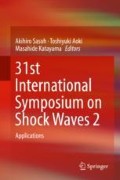Abstract
Decaying modes of propagation of flame front in narrow channel for acetylene-air mixtures were investigated experimentally using optical methods of diagnostics. Experiments were carried out using an open detonation channel of square cross section with transverse dimension of 3 mm and length of 1000 mm. It was connected to the detonation tube of large diameter 20 mm and length of 3000 mm. Trajectories of propagation of glowing combustion products (streak images) and frames of the reaction zone were obtained. Oscillating form of the propagation of the combustion inside the narrow channel after the decay of the stationary Chapman-Jouguet detonation into the shock wave and the flame front was registered. Parameters of velocity oscillation were obtained. The time interval of oscillations and spatial interval were measured. After the decay of the detonation wave, the average velocity of the flame front decreases first to 1000 m/s and then to 200 m/s. Minimum recorded value of the flame velocity was presented. It was shown that in spite of the substantial thermal losses to the channel walls, the propagation of detonation-like galloping combustion is possible in channels of subcritical size.
Access this chapter
Tax calculation will be finalised at checkout
Purchases are for personal use only
References
Z.W. Huang, M.H. Lefebvre, P.J. Van Tiggelen, Experiments on spinning detonations with detailed analysis of the shock structure. Shock Waves 10, 119 (2000)
Y. Wu, J.H.S. Lee, Stability of spinning detonation waves. Combust Flame. 162, 2660 (2015)
H.S. Dou, B.C. Khoo, Effect of initial disturbance on the detonation front structure of a narrow duct. Shock Waves 20, 163 (2010)
Y. Huang, H. Ji, F. Lien, H. Tang, Numerical study of three-dimensional detonation structure transformations in a narrow square tube: From rectangular and diagonal modes into spinning modes. Shock Waves 24, 375 (2014)
C. Wang, Z. Yongyao, Z. Bo, Numerical simulation of flame acceleration and deflagration-to-detonation transition of ethylene in channels. J Loss Prev Process Ind. 43, 120 (2016)
A.A. Vasil’ev, Quasi-steady regimes of wave propagation in active mixtures. Shock Waves 18, 245 (2008)
N. Tsuboi, Y. Morii, A.K. Hayashi, Two-dimensional numerical simulation on galloping detonation in a narrow channel. Proc Combust Inst. 34, 199 (2013)
V.I. Manzhalei, Low-velocity detonation limits of gaseous mixtures. Combus Explos Shock Waves. 35, 294 (1999)
M.-H. Wu, C.-Y. Wang, Reaction propagation modes in millimeter-scale tubes for ethylene/oxygen mixtures. Proc. Combust. Inst. 33, 2287 (2011)
M.-H. Wu, W.-C. Kuo, Transmission of near-limit detonation wave through a planar sudden expansion in a narrow channel. Combust. Flame 159, 3414 (2012)
A. Camargo, H.D. Ng, J. Chao, J.H.S. Lee, Propagation of near-limit gaseous detonations in small diameter tubes. Shock Waves 20, 499 (2010)
Y. Gao, H.D. Ng, J.H.S. Lee, Experimental characterization of galloping detonations in unstable mixtures. Combust. Flame 162, 2405 (2015)
A.A. Vasil’ev, Cell size as the main geometric parameter of a multifront detonation wave. J~Propul Power. 22, 1245 (2006)
F. Zhang, Shock Waves Science and Technology Library, 6: Detonation Dynamics (Springer Science & Business Media, Berlin-Heidelberg, 2012), pp. 266–267
Acknowledgments
This work was supported by the Russian Foundation for Basic Research under grant no. 15-38-70017, 16-38-00682-mol-a and grant of President of the Russian Federation no. SP-1501.2016.1.
Author information
Authors and Affiliations
Editor information
Editors and Affiliations
Rights and permissions
Copyright information
© 2019 Springer Nature Switzerland AG
About this paper
Cite this paper
Golovastov, S.V., Bivol, G.Y. (2019). Decaying Modes of Propagation of Detonation and Flame Front in Narrow Channel. In: Sasoh, A., Aoki, T., Katayama, M. (eds) 31st International Symposium on Shock Waves 2. ISSW 2017. Springer, Cham. https://doi.org/10.1007/978-3-319-91017-8_16
Download citation
DOI: https://doi.org/10.1007/978-3-319-91017-8_16
Published:
Publisher Name: Springer, Cham
Print ISBN: 978-3-319-91016-1
Online ISBN: 978-3-319-91017-8
eBook Packages: EngineeringEngineering (R0)

